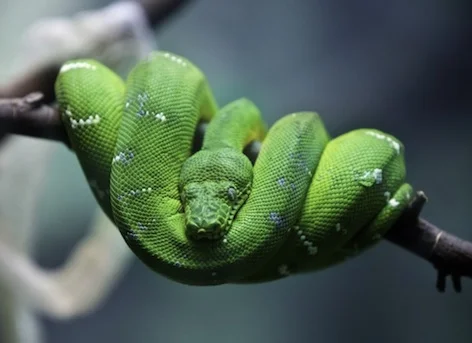Snakes, lizards and turtles are reptiles.
Some of them can be pets.
Pet reptiles need a warm place to live.
They need water and rocks and sand.
They need water.
Pythons can get very big and heavy. ©Getty Images
What are reptiles and amphibians?
Read the kidcyber page about what they are and what is the difference between them : reptiles and amphibians.
In Australia, native reptiles and amphibians are protected.
This means they cannot be collected from the wild to be kept as a pet. That includes a wild one that you may find in your own garden. However, there are many specialist pet shops that sell the kind of reptiles and frogs that you can keep as a pet. You need a government licence, and the shop will help you to get one.
It is illegal to keep a non Australian reptile as a pet in Australia.
Before you get a reptile pet, be very clear about why you want one. Reptiles are not cuddly animals, and do not need human companions.
They have special needs, they may tolerate some handling, but may on occasion bite their owners. Like all baby animals, baby reptiles look very cute... but first check out the grown up ones to see the size they grow to and how they are handled.
Bearded dragons ©Getty Images
Apart from the cost of buying the pet, there is the cost of housing that must include a heat source because reptiles control their body temperature by sitting in cooler or warmer parts of their enclosure.
You need to find out what it eats, how much and how often. And remember: reptiles live for a long time, so you will be making a long term commitment if you buy a reptile.
Setting up a home for your pet reptile
Once you decide to get a reptile pet, set up its home first, before you collect the pet. It should be set up and operating correctly when the pet is brought home. The reptile specialist will tell you about the required size and what is needed, but the bigger the better for lizards. You will need special heat lights so that your pet can bask, a cooler area, a thermometer so you can keep check on the required temperature, rocks and shelves. Fresh, clean water is important.
Frilled neck lizard©Getty Images
Frilled neck lizards and bearded dragons are fed fresh vegetables, crickets and other insects dusted with calcium powder, and special dried food pellets, and mealworms.
Blue tongue lizard ©Getty Images
Blue tongue lizards are easy to look after, and are easily handled. A fish tank is a suitable home for a blue tongue, of course with heat lamps and a cooler area.
Blue tongues eat plants and meat, including a variety of fruit and vegetables. As well as insects they can be fed lean chicken and beef mince and small amounts of cat food.
Marbled geckos are easy to look after and require no heat or lighting as they are nocturnal. They need wood and rocks as places to hide, and a substrate (material on the bottom of the tank) for them to burrow into.
Ball python ©Getty Images
Snakes need an enclosure that is not huge, or they will become anxious. Some need rocks and a climbing branch, other kinds need lots of branches and vines. A snake needs a hidey-hole like a space under a rock where it can hide. Snakes need a basking light. Some can have some direct sunlight each day. Snakes need under-floor heating, such as a heat pad placed under one section of the tank. They need a warm spot, a cool spot and an in between warm spot.
Green tree snake ©Getty Images
Snakes do not require much exercise, but with the availability of rocks and branches to climb, will do well.
Snakes are carnivores and eat their meal whole, with the skin and all the insides. Many snakes eat rats and mice, some eat frogs or other reptiles, and small ones eat insects.
Most pet snakes will accept dead food, and snake food can be bought already frozen from special reptile shops. Some snakes prefer live food, and owners have to jiggle the food so that it looks alive.
Clean water is essential for snakes.
Turtles are also popular pets. Pet turtles can be kept inside or outside.
Responsible pet ownership
Pet reptiles and amphibians depend on their owners for food, protection and shelter. Before becoming a pet owner think carefully about all the things you will have to do to care for your pet responsibly.
One snake often kept as a pet is the children's python. Read about looking after it:
Read about looking after some Australian lizards:
http://australianmuseum.net.au/shingleback-lizard









